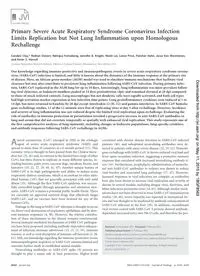
2012 Primary Severe Acute Respiratory Syndrome Coronavirus Infection Limits Replication but Not Lung Inflammation upon H PDF
Preview 2012 Primary Severe Acute Respiratory Syndrome Coronavirus Infection Limits Replication but Not Lung Inflammation upon H
Primary Severe Acute Respiratory Syndrome Coronavirus Infection Limits Replication but Not Lung Inflammation upon Homologous Rechallenge Candice Clay,* Nathan Donart, Ndingsa Fomukong, Jennifer B. Knight, Wanli Lei, Lance Price, Fletcher Hahn, Jesse Van Westrienen, and Kevin S. Harrod Lovelace Respiratory Research Institute, Infectious Disease Program, Albuquerque, New Mexico, USA Our knowledge regarding immune-protective and immunopathogenic events in severe acute respiratory syndrome corona- virus (SARS-CoV) infection is limited, and little is known about the dynamics of the immune response at the primary site of disease. Here, an African green monkey (AGM) model was used to elucidate immune mechanisms that facilitate viral clearance but may also contribute to persistent lung inflammation following SARS-CoV infection. During primary infec- tion, SARS-CoV replicated in the AGM lung for up to 10 days. Interestingly, lung inflammation was more prevalent follow- ing viral clearance, as leukocyte numbers peaked at 14 days postinfection (dpi) and remained elevated at 28 dpi compared to those of mock-infected controls. Lung macrophages but not dendritic cells were rapidly activated, and both cell types had high activation marker expression at late infection time points. Lung proinflammatory cytokines were induced at 1 to 14 dpi, but most returned to baseline by 28 dpi except interleukin 12 (IL-12) and gamma interferon. In SARS-CoV homolo- gous rechallenge studies, 11 of the 12 animals were free of replicating virus at day 5 after rechallenge. However, incidence and severity of lung inflammation was not reduced despite the limited viral replication upon rechallenge. Evaluating the role of antibodies in immune protection or potentiation revealed a progressive increase in anti-SARS-CoV antibodies in lung and serum that did not correlate temporally or spatially with enhanced viral replication. This study represents one of the first comprehensive analyses of lung immunity, including changes in leukocyte populations, lung-specific cytokines, and antibody responses following SARS-CoV rechallenge in AGMs. A novel coronavirus (CoV) emerged in 2002 as the etiologic agent of severe acute respiratory syndrome (SARS) and spread to more than 30 countries in a 6-month period (51). This zoonotic virus is thought to have passed from the Chinese horse- shoe bat (23, 26) and, in contrast to the limited host range of other CoVs, has been shown to replicate in many different species, in- cluding humans, palm civets, raccoon dogs, monkeys, ferrets, and hamsters (10, 22, 27, 29, 40, 41, 47). Another unique feature of SARS-CoV is its high pathogenicity and ability to induce acute respiratory distress syndrome, which is in contrast to other iden- tified human CoVs that are generally associated with only mild illness (35). Although the first SARS-CoV epidemic was success- fully controlled largely through quarantine and sanitation mea- sures, SARS-CoV remains a potential public health threat. There are currently no approved antiviral drugs that effectively target SARS-CoV, and no vaccines have been licensed for any of the human CoVs. Damage to the lung in SARS-CoV infection is thought to occur via direct viral destruction of respiratory epithelium and by aber- rant immune responses (4, 38). However, the relative contribu- tion of these mechanisms to the disease remains controversial. Several immune-mediated mechanisms of SARS-CoV pathogen- esis have been proposed, including antibody-dependent enhance- ment of infection, immune subversion (13, 15, 21, 30), immune evasion, as well as viral disruption of immune cell function (2, 38, 61). Still, our knowledge regarding the immune-protective versus immunopathogenic responses to SARS-CoV remains limited and warrants further study in established animal models. Neutralizing antibodies to SARS-CoV spike (S) protein are thought to play a major role in host protection. Higher levels correlated with shorter disease duration in SARS-CoV-infected patients (46), and suboptimal neutralizing antibodies were de- tected in patients with more severe disease (32, 33, 52). Homolo- gous rechallenge with SARS-CoV in ferrets reduced viral load and fever upon secondary infection, suggesting a protective memory response that correlated with increased neutralizing antibody ti- ters (10). Furthermore, prophylactic administration of monoclo- nal anti-SARS-CoV antibodies to rodents was shown to reduce viral burden and associated lung pathology (17, 47). However, humoral responses to viral infections are complex, as antibodies have also been shown to increase viral replication and severity of disease in several models, including dengue virus, flavivirus, and feline infectious peritonitis virus (34, 45). Although similar mech- anisms have not been observed in most SARS-CoV immunization studies (38, 40), severe hepatitis was reported in immunized fer- rets and was thought to be mediated by antibody enhancement of SARS-CoV infection in the liver (50). In addition, recombinant viral vectors coated with SARS-CoV S protein showed antibody- dependent increased entry into 786-O cells, and therefore the pos- Received 18 November 2011 Accepted 2 February 2012 Published ahead of print 15 February 2012 Address correspondence to Kevin S. Harrod,
